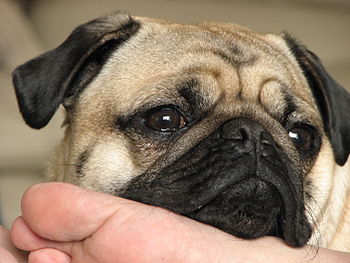 |
| A Pug dog. (Photo credit: Wikipedia) |
History: Two schools of thought contend over the origin of the Pug. It is the most generally accepted that the Pug came into being in Asia and is a descendant of the Pekingese. It was mentioned in the writings of Confucius and was a favorite among the Chinese royalty and nobility. The Pug was also kept in Tibetan monasteries. It was the Dutch East India Company that brought the Pug to Europe in the 16th century. The Pug was almost instantly popular and is featured in a self-portrait of the artist Hogarth.
Temperament: The Pug is an affectionate, outgoing dog that loves to be around people. It is something of a clown and often amuses its family with its playful antics. The Pug is very good with children and enjoys playing with them. The Pug is a confident and alert dog that will keep an eye on the house, without excessive happiness. It gets along fine with other dogs and family pets.
Health Issues: Due to its short muzzle, the Pug is susceptible to the usual problems that affect brachycephalic breeds. The Pug will snore and wheeze and can suffer from "snort attacks", which are alarming but not dangerous. The Pug can suffer from hip dysplasia, and this occurs in a majority of these dogs. Be careful that your Pug does not become overweight as this can make breathing and joint problems worse. A very serious ailment is Pug Dog Encephalitis, which causes brain inflammation in young dogs. A cesarean section is often necessary to deliver the pups.
Grooming: The lighter colored Pugs, fawn and apricot, can be fairly heavy shedders, especially seasonally, and should be brushed regularly. The black Pug sheds much less and does not need to be tended to as much. The wrinkly face of the Pug needs to be kept clean and dry as infections can develop in the moist wrinkle creases.
Living Conditions: The Pug is perfect for indoor living, being equally comfortable in a house or apartment. It should have a daily walk to keep it healthy, but these should be skipped in hot weather. Because of the short face of the Pug, it must be protected from both heat and cold. It can suffer heat stroke very easily and should be kept cool during the summer. The Pug will want to be with its human family as much as possible.
|


